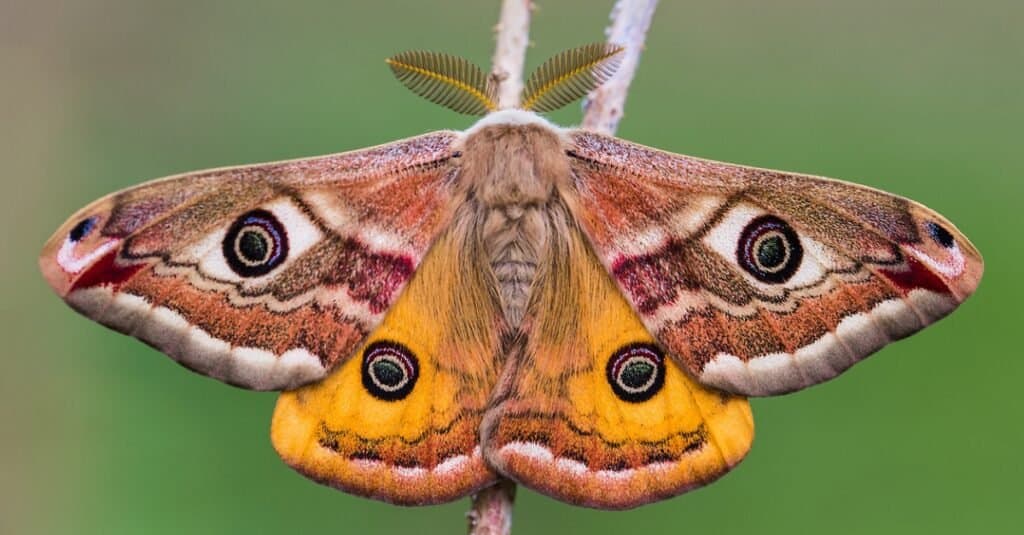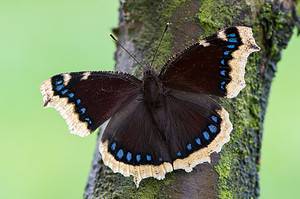The answer to the question “Do butterflies drink blood?” is “Yes.” Now, they don’t attack people or animals to drink their blood the way mosquitoes or horseflies do. For one thing, butterflies don’t have those piercing mouthparts that can break skin and blood capillaries. However, it will sip blood if offered. It’s not all that gruesome. The butterfly just needs the minerals found in the blood. They drink blood the same way they drink urine, tears, sweat, moisture from fecal matter, and the liquid that oozes from rotting fruit and decaying corpses. Indeed, there are a lot of surprising butterfly facts! Here are a few of them:
1. Zebra Longwings Eat Pollen

©iStock.com/ktreffinger
Lots of people believe that all butterflies eat pollen as well as sip nectar. This is untrue. As far as biologists know, the zebra longwing butterfly is one of the few butterflies that actually eat pollen. It sticks its proboscis into the flower and moves it around to make sure that the pollen sticks to it. The butterfly’s saliva allows the pollen to be instantly digested, which frees up amino acids, the building blocks of protein. Because it can eat pollen, the zebra longwing lives longer than most other butterflies. Not only this, the pollen is turned into a type of cyanide in the butterfly’s body, which makes it toxic to would-be predators.
This beautiful butterfly, which is the state butterfly of Florida, is unmistakable because of its long, oval wings striped in black and white like a zebra’s coat. It’s also found in the Caribbean and as far south as South America. They lay their eggs on passionflower plants, but also take nectar from lantanas, verbenas, and asters.
2. Butterflies Are Younger than Moths
Lepidopterans, members of the order that contains both butterflies and moths, evolved around 200 million years ago. Butterflies probably appeared maybe 100 million years after that in the mid-Cretaceous period. Most butterflies belong to the Papilionoidea superfamily. There are 20,000 to 25,000 species of butterfly in the world and even more types of moth.
3. Some Butterfly Colors are Optical Illusions
Butterflies have vibrant colors and intricate patterns. Pigments in the butterfly’s wings make up reds, browns, and yellows. New research, however, has shown that some of the brilliant tones are due to structural coloration.
Scales cover butterfly wings, which gave the order its name. Lepis means “scale” and pteron means “wing” in ancient Greek. Scales create colors because light hits them as they move. The scales bend and reflect light by structural coloration. These colors tend to be greens, reds, and blues.
4. Some Butterflies Have Long Migrations

©Dotted Yeti/Shutterstock.com
Butterflies such as the monarch and the painted lady travel for what can be thousands of miles. They navigate by orienting themselves to the sun, and since they can see polarized light they can travel even on cloudy days. Because butterflies don’t live very long and are fragile, these migrations can take generations to accomplish. For example, a round trip between Africa and northern Europe started by a painted lady can be completed by her great-great-great-granddaughter.
By the way, the monarch butterfly doesn’t fly all the way to Mexico to reproduce. It goes there to get away from the colder temperatures of its northern range. Butterflies can’t fly well if their body temperature is less than 85 degrees Fahrenheit and can’t fly at all if the air temperature is less than 55 degrees F.
Go here to learn more about the monarch butterfly.
5. The Longest Lived Butterfly Lives for About a Year
Though the zebra longwing butterfly has a relatively long life because it eats pollen, the longest-lived butterfly is the brimstone butterfly. There is a bit of a trick to the brimstone’s longevity, for it needs close to two months to develop from an egg to a caterpillar to a pupa and finally to an adult, and the adult spends seven months of its life hibernating. Because its wings resemble leaves, the brimstone can cling to a tree branch while hibernating and not be noticed by predators. Its found in North Africa, Asia, and Europe.
Go here to see how long butterflies live.
6. Some Butterflies Make Sounds
Though most butterflies are wonderfully silent as they fly or feed, another of the surprising facts about butterflies is that some do make noises. The cracker butterflies are noteworthy because the male makes a cracking sound when he’s defending his territory or trying to attract a mate. The queen cracker is an exceptionally beautiful member of the species. The male has rounded, dark wings spotted with metallic blue, and he makes the unique sound by clapping them together. The females are larger and have a white band on their forewing as well as metallic blue markings. They also make a cracking noise.
7. A Butterfly Takes a Number
The 88 butterfly has the number 88 on the underside of both of its hindwings. The upper part of the butterfly’s wings are brown with a white diagonal band on the forewing, but the underside of the forewings are orange with brown and white bands, and the 88 on the hindwings. This little butterfly is found in South American and Central American rainforests and has a wingspan of 1.5 to 1.75 inches.
8. Butterfly vs. Moth

©iStock.com/Simon002
Butterflies can be told from moths, usually, because their antennae are slender and knobbed at the tips. The antennae of most moths are furry or resemble threads and lack knobs. Moths are usually nocturnal while most butterflies fly during the day.
Butterflies also tend to have more slender bodies than moths, whose bodies tend to be robust and furry. There are exceptions. The Koh-i-Noor and the night butterfly fly at dusk, and Uraniidae moths, which look suspiciously like butterflies, fly during the day, as does the male tau emperor moth. The female tau emperor moth flies at night. The bodies of some Nymphalidae butterflies are also fuzzy and fat, including the jeweled nawab of Oceania and Southeast Asia and the large blue charaxes of Africa.
For more information about butterflies vs. moths, read this.
9. Taste Receptors in the Feet
A butterfly’s sense of taste is found in its feet, not in its proboscis. To get the taste of the plant, the female scratches at it with her feet. This is important because a female butterfly needs to taste a plant and know what it is before she lays her eggs on it. Some caterpillars only feed on one type of plant. These caterpillars include the monarch that eats milkweed and the zebra longwing that eats passionflowers. Butterflies use their antennae to smell and check the wind.

©iStock.com/SW_Olson
10. Ants Raise Most Lycaenidae Caterpillars
Lycaenidae butterflies are a huge family of butterflies made up of blues, harvesters, hairstreaks, and coppers. One of the surprising facts about these butterflies is that many of them use ants to raise their caterpillars. The large blue butterfly lays her eggs on a plant. The caterpillar eats until it’s a certain size then drops to the ground where it’s picked up by ants. The ants don’t kill and eat the caterpillar because the caterpillar releases pheromones that mimic the pheromones of ant larvae. This makes the grown ants want to take care of the caterpillar. So, they carry the caterpillar to their colony and feed it. Other caterpillars make a noise that mimics a noise the queen ant would make. This not only makes the ants take care of it but privilege its care over anything else in the colony.
A third, nastier strategy is for the caterpillar to mimic an ant larva while feasting on real ant larvae. Fortunately, sometimes the ants are on to the subterfuge and kill and eat the caterpillar.
11. Butterflies Don’t Defecate
Most butterflies drink nectar (or drink blood or sweat or urine or tears), but they don’t defecate. One reason for this is that nectar is a liquid, and it’s difficult to get any solid waste out of it. Also, the butterfly’s digestion is so efficient that it uses every bit of what it ingests for energy. However, if it eats too much, it might expel the excess, and most of that liquid is nothing but water.
12. Butterflies are Slow
Skipper butterflies can fly as fast as 37 miles an hour, but most butterflies are slow fliers that don’t go much faster than 12 miles an hour. Butterfly wings also work in a figure-eight pattern, and the path of their flight is famously erratic.
13. Some Butterflies Have Transparent Wings
If a butterfly does not have scales on a part of its wing, that part of the wing is transparent like a windowpane. There are several types of butterflies with transparent wings. One is the big greasy butterfly of Oceania and Southeast Asia. The forewings of the male are almost completely transparent and the hindwings have large areas of transparency. Females emerge with gray scales on their wings, but they soon slough off, and the wings have a greasy appearance that gives the butterfly its name.
Other butterflies with transparent wings are the black-veined white of northern Asia, Europe, and North Africa and the Esmeralda and small thyridia of Central and South America.
13 Surprising Butterfly Facts
| 1 | Zebra Longwings Eat Pollen |
| 2 | Butterflies Are Younger than Moths |
| 3 | Some Butterfly Colors are Optical Illusions |
| 4 | Some Butterflies Have Long Migrations |
| 5 | The Longest Lived Butterfly Lives for About a Year |
| 6 | Some Butterflies Make Sounds |
| 7 | A Butterfly Takes a Number |
| 8 | Butterfly vs. Moth |
| 9 | Taste Receptors in the Feet |
| 10 | Ants Raise Most Lycaenidae Caterpillars |
| 11 | Butterflies Don’t Defecate |
| 12 | Butterflies are Slow |
| 13 | Some Butterflies Have Transparent Wings |
Up Next…
Enjoy these surprising butterfly facts? Here are more about these beautiful, delicate creatures.
- 10 Poisonous Butterflies Predators should avoid eating these pretty but poisonous butterflies.
- What Do Butterflies Eat? Find out what butterflies eat exactly.
- What Flowers Attract Butterflies? Plant a butterfly garden next spring!
The photo featured at the top of this post is © iStock.com/ikuyan
Thank you for reading! Have some feedback for us? Contact the AZ Animals editorial team.






